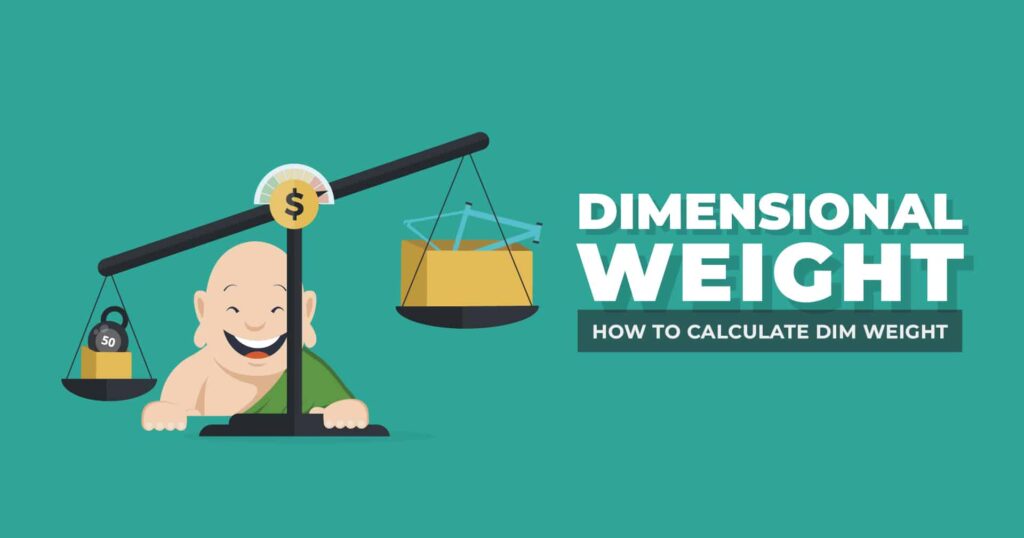When you mail a birthday gift to your mom, you take it to the post office or a UPS store, and the first thing the worker behind the counter does is put it on a scale. Then they get out a tiny measuring tape and measure all 3 dimensions. They input all this info into their system and—voila!—out comes a shipping price. Your jaw drops, you sigh and then resignedly surrender your payment device. Wouldn’t it be nice to know how much it’s going to cost before you go? Maybe you would’ve sent a nice gift card instead.
As an eCommerce business owner, you know how expensive shipping can be. What you may not know is that you could end up paying more to ship a large lightweight item than a small heavy one when the carrier uses the dreaded dimensional weight pricing (or DIM weight pricing).
There are ways to reduce dimensional weight and, as a result, reduce shipping costs, but first you have to understand how shipping costs are calculated. Read on to learn how to calculate DIM weight and minimize its effect on shipping costs.
4 Factors That Determine Shipping Costs
All major carriers including USPS, FedEx and UPS use the same four factors to calculate shipping costs: package weight, dimensions, the distance it’s traveling, and how fast it needs to get there. Additional (and sometimes unexpected) charges like fuel or peak holiday surcharges can also add to the cost.
1. Weight (actual weight in pounds)
2. Dimensional weight (a formula involving size and weight)
3. Shipping zones (how far it has to go)
4. Speed (how fast the customer wants it)
What is Dimensional Weight?
Shipping carriers, like FedEx, UPS, USPS and DHL, charge customers for two things: their services (like speed and reliability) and physical space in their truck or airplane. Meanwhile, they have a lot of costs to cover. So the more packages they can fit into a trailer or cargo hold, the more money they’ll make on a trip across the country.
Dimensional weight, a.k.a. DIM weight or volumetric weight, is a pricing formula adapted by shipping carriers to charge customers for the volume (cubic inches per pound) their package takes up. And, like an airplane seat with more legroom, the more space you take up, the more you’re going to pay.
How is DIM Weight Calculated?
No matter which carrier you use, they follow the same steps as your local post office to calculate DIM weight. They weigh it, then measure all 3 dimensions at their largest point, rounding up each number to the nearest inch as they go. Then they multiply the width x length x height, and divide that number by a mysterious number called the DIM factor (sometimes called the “DIM divisor” or “density ratio”). The result is the DIM weight.
Note: the calculations are similar for metric, using centimeters for dimensions, but you’ll use different DIM factors and the DIM weight is expressed in kilograms. For the sake of simplicity, we’ll stick with inches and pounds for this article.
What is This Mysterious DIM Factor?
Not all space is equal. Clearly, a seat on a SpaceX Crew capsule is way cooler than a seat on a Greyhound bus. Shipping carriers know this and charge accordingly. To ensure profitability, each shipping carrier sets its own DIM factor, or the maximum cubic inches per pound they will accept. Because this number is the divisor in the equation above, the higher the DIM factor, the lower the DIM weight.
Some carriers (like UPS) will charge their regular business customers one rate, and infrequent customers a different retail rate. Because space and weight limitations vary between air freight, ocean, rail or road, some shipping carriers (like DHL) use a different DIM factor for each mode of transportation.
DIM Factors by Shipping Carrier
FedEx uses a DIM factor of 139 (or 5,000 if you’re measuring in centimeters) for all shipments.
UPS uses a DIM factor of 139 (or 5,000 for cm) for its regular business customers, and 166 (or 6,000 for cm) for infrequent customers in its retail stores. Package size is limited to no longer than 108 inches on the longest side, and no more than 150 pounds or 70 kilograms.
DHL doesn’t use DIM weight to determine billable weight unless the package is larger than 1 cubic foot. Above that, they use a different DIM factor (they call it density ratio) for each mode of transportation. For air freight the DIM factor is 166, (or 6000 for cm); for most domestic shipments it’s 139 (or 5,000 for cm). There is a weight limit of 150 pounds or 70 kgs per package.
USPS doesn’t calculate DIM weight unless the package is larger than 1 cubic foot. Above that, they use a DIM factor of 166. There is a weight limit per package of 70 pounds.
You can check each carrier’s DIM weight calculator for the most up-to-date information: FedEx, UPS, DHL, and USPS.
How Does DIM Weight Affect eCommerce Shipping Costs?
After calculating a package’s DIM weight, shipping carriers will then compare the DIM weight to the package’s actual weight in pounds. The larger of the two numbers becomes the package’s billable weight.
Of course, shipping carriers still need to factor in the distance the package is traveling (measured in shipping zones), and the delivery speed selected by the customer. Each carrier uses its own pricing structure to apply their shipping rates to each package, based on its billable weight (DIM or actual), zone and shipping method.
As you can see, DIM weight is just one factor that goes into estimating eCommerce shipping costs. If the DIM weight is higher than the actual weight of the package, it’s going to become the billable weight, no matter how light your package is. That means the final shipping cost may be higher than you expect.
To see how different DIM factors affect shipping costs across carriers, check out ShipMonk’s dimensional weight calculator. Click on the info button under each calculation to see the DIM factor used.
Dimensional Weight Calculator
So if you can’t do anything about your carrier’s DIM factor or its shipping rates, how can you reduce shipping costs when DIM weight is in play?
How to Reduce eCommerce Shipping Costs
If you’re not paying attention to package size and weight or comparing shipping carriers, higher-than-expected shipping costs could eat away at your profit margins. Here are a few things you can do to reduce shipping costs, or at least make sure you’re not paying too much.
Change Shipping Carriers — Maybe you can’t change your carrier’s rates, but you can change carriers. That’s why it’s important to compare eCommerce shipping services and find out which one will charge the least to ship your packages. Maybe you’ll be better off using one carrier for shipping heavy orders, and another for lighter ones. USPS and DHL have the highest DIM factors and therefore the lowest
Reduce the Size of Your Packages — Are you using bigger boxes than you need? Too much or the wrong type of dunnage? Can you vacuum pack the items to reduce their size? The smaller you can make the package, the lower the DIM weight will be.
Use a Tech-Savvy 3PL Fulfillment Provider — Measuring, weighing, and choosing the best carrier for every package you send out sure sounds fun, doesn’t it? If you’re getting to the point where you can’t keep up, it’s time to hire a third party logistics (3PL) provider that does this sort of thing for a living.
A tech-forward 3PL like ShipMonk has automatic dimension systems that measure and weigh packages to calculate DIM weight in one pass. They have huge carrier networks and access to discounted shipping rates using global, national, regional, and local carriers. They have routing systems that automatically select the most efficient route and carrier(s) for each and every package, no matter what size. And they can help you find the best way to pack your goods so you’re not paying to ship a box full of air.





